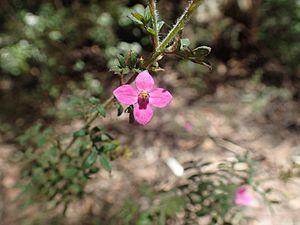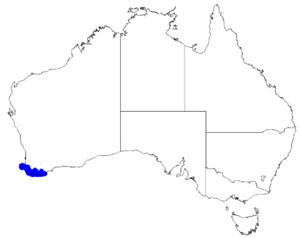Karri boronia facts for kids
Quick facts for kids Karri boronia |
|
|---|---|
 |
|
| Boronia gracilipes in the Australian National Botanic Gardens | |
| Scientific classification | |
 |
|
| Occurrence data from Australasian Virtual Herbarium |
The Karri Boronia (scientific name: Boronia gracilipes) is a special plant. It belongs to the citrus family, just like oranges and lemons! This plant is found only in the south-west part of Western Australia. It's a tall, thin shrub with pretty pink flowers. Each flower has four petals.
Contents
What Does Karri Boronia Look Like?
The Karri Boronia is a shrub that stands upright and looks a bit spindly. It usually grows between 0.3 and 1.2 metres (about 1 to 4 feet) tall. Its stems are covered with long, soft hairs.
This plant has flat, compound leaves. This means each leaf is made up of smaller parts called leaflets. These leaves are less than 10 millimetres (about 0.4 inches) long. They usually have five or seven small, pointed leaflets.
The flowers are a lovely pink colour. They grow one by one where the leaves meet the stem. Each flower sits on a stalk called a pedicel, which is 10 to 30 millimetres long. The four green parts under the petals, called sepals, are shaped like triangles or are almost round. They overlap at their bases.
The pink petals are about 8 millimetres long. They are smooth and also overlap at their bases. The part of the flower that receives pollen, called the stigma, is large and oval. Karri Boronia flowers mostly from July to December.
How Did Karri Boronia Get Its Name?
The Karri Boronia was first officially described in 1860. A famous botanist named Ferdinand von Mueller gave it its scientific name, Boronia gracilipes. He published his description in a book called Fragmenta phytographiae Australiae.
The second part of its name, gracilipes, comes from two Latin words. Gracilis means "slender" or "thin". Pes means "foot". So, the name describes its slender, foot-like stalks.
Where Does Karri Boronia Grow?
Karri Boronia likes to grow in shady spots. You can find it in gullies and on granite rocks. It lives in specific areas of Western Australia. These areas include the Esperance Plains, Jarrah Forest, and Warren regions.
Is Karri Boronia Protected?
Good news! The Karri Boronia is not considered to be in danger. The Western Australian Government's Department of Parks and Wildlife has classified it as "not threatened". This means there are enough of these plants in the wild.

